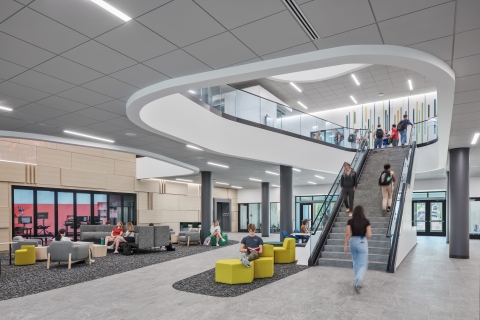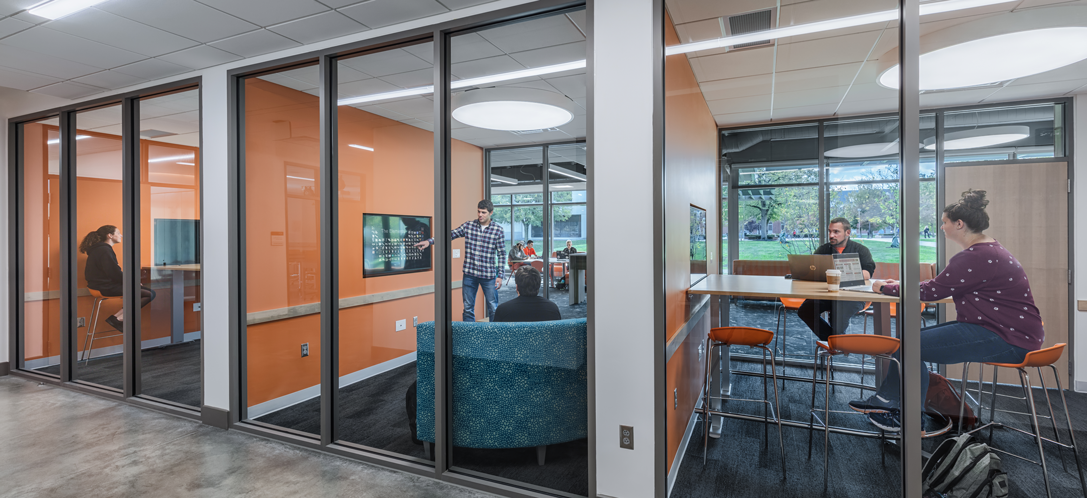
Understanding Generation Alpha: Designing Spaces for a Tech-Savvy and Social Future

As Generation Z reaches the peak of college attendance and Millennials continue raising families, a new question has emerged: who is the next generation, and how will they shape the world around us? More specifically, how might they shape the university campus of the future?
In this blog, we will explore what we know about Generation Alpha and its potential influence on higher education design based on current research and trends.
Generations Defined
To understand the rise of Generation Alpha, we must first examine the broader context of generational cycles. Generational naming is rooted in sociological research that identifies shared experiences, historical events, and cultural trends. While start and end dates for each generation are debated, the characteristics of one generation often overlap with the next.
Here’s a brief overview of the previous generations, helping us build a framework for understanding Generation Alpha:
- Silent Generation (1928-1945): Shaped by the Great Depression and World War II, this generation valued hard work, frugality, and stability.
- Baby Boomers (1946-1964): Known for their impact on cultural, social, and political shifts, Boomers influenced societal trends like civil rights and technological progress.
- Generation X (1965-1980): Raised during rapid technological change and economic uncertainty, Gen Xers are often seen as pragmatic and independent.
- Millennials (1981-1996): The first generation to grow up with the internet and mobile technology, Millennials value experiences, diversity, and social causes.
- Generation Z (1997-2012): Born into a digital world, Gen Zers are tech-savvy, socially conscious, and adept at navigating online platforms.
Now, we shift our focus to Generation Alpha, the cohort born from 2013 onwards, who are expected to shape the future in unprecedented ways.
Who is Generation Alpha?
Generation Alpha is the first to be entirely born in the 21st century, a time defined by rapid technological advancement, globalization, and shifting societal norms. As they mature, their experiences and perspectives will differ significantly from previous generations, primarily due to their early immersion in digital technology.
Key traits that will define Generation Alpha:
- Technological Fluency: They are exposed to digital devices almost from birth, making technology an inherent part of their learning, communication, and daily life.
- Together Alone: They are a social cohort that prefers smaller groups over large crowds.
- Social Justice: Unlike previous generations that fought for social justice reform, this generation will grow up in a world where that reform has been normalized and widely accepted.
- Holistic Wellness and Personal Growth: Prioritizing physical, mental, and emotional well-being and growth will likely be central to how they engage with the world.
But how do these defining characteristics translate into design considerations for higher education, retail, and healthcare?
Predictive Generational Modeling and Design Implications
At BHDP, we’ve developed and utilized a tool called persona mapping to analyze how generational traits impact design. By mapping out behavioral trends and key influences, we can anticipate the needs and desires of Generation Alpha as they mature.
The primary factors we use in this model include:
- Global/National Wildcard Events
- Political Climate
- Social Issues
- Technological Advances
- Education/Workforce Trends
- Economic Conditions

This graphic displays the primary and secondary categories for generation persona mapping as it relates to higher education. To support our research, BHDP created persona maps for generations dating back to the Greatest Generation (1901-1927).
We applied this framework to previous generations to validate assumptions, then used it to predict how Generation Alpha’s traits will manifest, particularly in higher education, retail, and healthcare.
Generation Alpha's Impact on Higher Education, Retail, and Healthcare
Higher Education
Higher education institutions must prepare for Generation Alpha’s expectations of seamless technology, wellness support, and personalized learning environments. Some trends that will influence campus design include:
- Holistic Wellness and Personal Growth: Physical and mental health will be integral to student life, requiring institutions to invest in fitness centers, counseling services, and medical facilities. As outlined in our blog, “Beyond Academics: The Importance of Holistic Wellness and Personal Growth in Higher Education,” the emphasis on student well-being is growing, and this generation will expect spaces that foster both personal and academic growth.
- Diversity, Equity, and Inclusion: For higher education institutions, providing inclusive student support services and developing infrastructure that reflects the current cultural landscape is vital. This involves integrating specialty spaces, such as multicultural and LGBTQIA+ centers, into universally accessible areas. Safety protocols and building designs should balance transparency with the need for privacy and secure shelter. As designers, we can help eliminate the stigma around support services like food pantries and clothing closets by locating them in high-traffic areas, incorporating glazing to showcase available resources, and designing these spaces to resemble traditional retail environments rather than storage areas.
- Small Group Socialization: Generation Alpha prefers a "together alone" approach, favoring small group interactions while engaging in larger social behaviors. To address their concerns about health and safety in large spaces, design implications include creating semi-enclosed areas within traditional library settings for intimate collaboration, subdividing outdoor spaces with furnishings, and incorporating smaller dining areas to reduce noise.
- Tech Integration: Technology is essential to Generation Alpha's campus experience and must be seamlessly integrated into various spaces like classrooms, dorms, and social areas to enhance their higher education journey. Institutions must provide flexible and adaptable technological solutions that cater to individual and group activities, accommodating the dynamic nature of their academic and social lives. As Generation Alpha expects technology to function effortlessly, it is crucial for institutions to ensure that it is consistently up-to-date and accessible throughout the campus.
For a more in-depth analysis of how to design for Generation Alpha, check out our white paper, “Meeting Generation Alpha's Student Life Needs in Higher Education.”

Study rooms at the Ohio Northern University James Lehr Kennedy Engineering Building offer a more intimate environment for students to collaborate or complete work together.
Retail
Retailers will need to adjust their strategies to cater to the social and tech-savvy nature of Generation Alpha. Here’s what we expect to see:
- Social Spaces: Malls and retail hubs must evolve into social destinations, upgrading communal areas like food courts to create engaging environments.
- Digital Integration: The shopping experience must merge digital and physical, such as incorporating interactive technology into retail spaces while maintaining human connections.
- Holistic Wellness in Retail: Consumers will expect more than just products—they will seek experiences that contribute to their overall well-being, from health-focused stores to wellness centers integrated into retail environments.

Fifth Third Bank’s CVG airport branch creates an immersive experience that captivates visitors the moment they approach. The interactive LED entry portal responds to movement, guiding visitors inside as its animations flow seamlessly onto the LED ceiling.
Healthcare
As healthcare becomes more consumer-driven, Generation Alpha will demand streamlined, tech-enhanced services. Key trends include:
- Technology-Driven Care: Technology integration in healthcare will have to keep pace with the digital expectations of Generation Alpha. While advancements have been made in recent years, such as telehealth options and online patient portals, the healthcare industry must continue innovating, particularly in the areas of user experience and seamless technology integration. For instance, many healthcare providers still require patients to call a phone number to schedule appointments, a method that Generation Alpha will find cumbersome. They will expect frictionless scheduling, digital communication, and remote access to healthcare at their fingertips.
- Disruptor Companies: Emerging companies offering digital-first health solutions, such as online prescriptions and telehealth consultations, will appeal to Generation Alpha's preference for convenience and speed.
- Crowdsourced Medical Knowledge: This generation will likely rely more on peer recommendations and digital influencers for healthcare advice than traditional doctors. These influencers, along with friends and digital communities, may feel more trustworthy to Generation Alpha than healthcare providers, especially when the provider lacks a personal relationship with the patient. Healthcare professionals must build trust with patients through more personal connections to stay relevant in this shifting dynamic.
Embracing the Future of Design for Generation Alpha
Generation Alpha will be a highly social, tech-forward, and wellness-driven generation that prioritizes inclusivity and sustainability. As their influence on industries grows, BHDP is dedicated to researching and applying these insights to help our clients stay ahead of the curve.
If you’re interested in learning more about how to design for Generation Alpha, please fill out the form below.
Author
Content Type
Date
November 05, 2024
Market
Practice
Topic
Technology
Campus Planning



